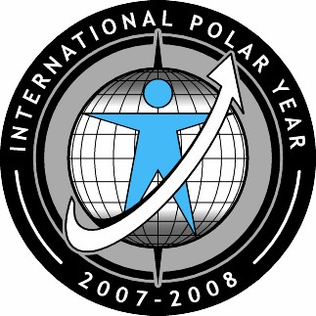Related Research Articles

The United Nations Environment Programme (UNEP) is responsible for coordinating responses to environmental issues within the United Nations system. It was established by Maurice Strong, its first director, after the United Nations Conference on the Human Environment in Stockholm in June 1972. Its mandate is to provide leadership, deliver science and develop solutions on a wide range of issues, including climate change, the management of marine and terrestrial ecosystems, and green economic development. The organization also develops international environmental agreements; publishes and promotes environmental science and helps national governments achieve environmental targets.

The International Polar Years (IPY) are collaborative, international efforts with intensive research focus on the polar regions. Karl Weyprecht, an Austro-Hungarian naval officer, motivated the endeavor in 1875, but died before it first occurred in 1882–1883. Fifty years later (1932–1933) a second IPY took place. The International Geophysical Year was inspired by the IPY and was organized 75 years after the first IPY (1957–58). The fourth, and most recent, IPY covered two full annual cycles from March 2007 to March 2009.

The International Union for Conservation of Nature (IUCN) is an international organization working in the field of nature conservation and sustainable use of natural resources. Founded in 1948, IUCN has become the global authority on the status of the natural world and the measures needed to safeguard it. It is involved in data gathering and analysis, research, field projects, advocacy, and education. IUCN's mission is to "influence, encourage and assist societies throughout the world to conserve nature and to ensure that any use of natural resources is equitable and ecologically sustainable".

The Global Environment Facility (GEF) is a multilateral environmental fund that provides grants and blended finance for projects related to biodiversity, climate change, international waters, land degradation, persistent organic pollutants (POPs), mercury, sustainable forest management, food security, and sustainable cities in developing countries. It is the largest source of multilateral funding for biodiversity globally, and distributes more than $1 billion a year on average to address inter-related environmental challenges.

The World Climate Research Programme (WCRP) is an international programme that helps to coordinate global climate research. The WCRP was established in 1980, under the joint sponsorship of the World Meteorological Organization (WMO) and the International Council for Science (ICSU), and has also been sponsored by the Intergovernmental Oceanographic Commission (IOC) of UNESCO since 1993.

The International Union of Biological Sciences (IUBS) is a non-profit organization and non-governmental organization, founded in 1919, that promotes the biological sciences internationally. As a scientific umbrella organization it was a founding member of the International Council for Science (ICSU).
The Global Earth Observation System of Systems (GEOSS) was built by the Group on Earth Observations (GEO) on the basis of a 10-Year Implementation Plan running from 2005 to 2015. GEOSS seeks to connect the producers of environmental data and decision-support tools with the end users of these products, with the aim of enhancing the relevance of Earth observations to global issues. GEOSS aims to produce a global public infrastructure that generates comprehensive, near-real-time environmental data, information and analyses for a wide range of users. The Secretariat Director of Geoss is Barbara Ryan.

The International Geosphere-Biosphere Programme (IGBP) was a research programme that ran from 1987 to 2015 dedicated to studying the phenomenon of global change. Its primary focus was coordinating "international research on global-scale and regional-scale interactions between Earth's biological, chemical and physical processes and their interactions with human systems."

Landscape-scale conservation is a holistic approach to landscape management, aiming to reconcile the competing objectives of nature conservation and economic activities across a given landscape. Landscape-scale conservation may sometimes be attempted because of climate change. It can be seen as an alternative to site based conservation.
Julia Marton-Lefèvre is a French - US environmentalist and academic. She studied history, ecology and environmental planning in the US and in France, and was born in Hungary.
The consultative process towards an IMoSEB was a multidisciplinary effort from 2005 to 2008 that involved a large number of stakeholders and had a considerable political and media audience. Its aim was the creation of a value-added process by taking into account existing and current initiatives and mechanisms.

The Earth System Governance Project is a long-term, interdisciplinary social science research programme originally developed under the auspices of the International Human Dimensions Programme on Global Environmental Change. It started in January 2009.

The Economics of Ecosystems and Biodiversity (TEEB) was a study led by Pavan Sukhdev from 2007 to 2011. It is an international initiative to draw attention to the global economic benefits of biodiversity. Its objective is to highlight the growing cost of biodiversity loss and ecosystem degradation and to draw together expertise from the fields of science, economics and policy to enable practical actions. TEEB aims to assess, communicate and mainstream the urgency of actions through its five deliverables—D0: science and economic foundations, policy costs and costs of inaction, D1: policy opportunities for national and international policy-makers, D2: decision support for local administrators, D3: business risks, opportunities and metrics and D4: citizen and consumer ownership.
The International Human Dimensions Programme on Global Environmental Change (IHDP) was a research programme that studied the human and societal aspects of the phenomenon of global change.

Anne Larigauderie is a French ecologist. She is currently the Executive Secretary of the Intergovernmental Platform on Biodiversity and Ecosystem Services (IPBES). She was previously the Head of Science in Society at ICSU, the International Council for Science, and the executive director of DIVERSITAS, the international scientific programme dedicated to biodiversity science, under the auspices of ICSU, and UNESCO.
Sustainable land management (SLM) refers to practices and technologies that aim to integrate the management of land, water, and other environmental resources to meet human needs while ensuring long-term sustainability, ecosystem services, biodiversity, and livelihoods. The term is used, for example, in regional planning and soil or environmental protection, as well as in property and estate management.
Earth system governance is a recently developed paradigm that builds on earlier notions of environmental policy and nature conservation, but puts these into the broader context of human-induced transformations of the entire earth system.

Tan Sri Zakri bin Abdul Hamid has had a distinguished career in science as a researcher, educator, administrator and diplomat.
Future Earth is an international research program which aims to build knowledge about the environmental and human aspects of Global change, and to find solutions for sustainable development. It aims to increase the impact of scientific research on sustainable development.

Diana Harrison Wall is the founding director of the School of Global Environmental Sustainability, a distinguished biology professor, and senior research scientist at the Natural Resource Ecology Laboratory at Colorado State University. She is an environmental scientist and a soil ecologist and her research has focussed on the Antarctic McMurdo Dry Valleys. Wall investigates ecosystem processes, soil biodiversity and ecosystem services and she is interested in how these are impacted by global change. The Wall Valley was named after her in recognition of her research in the McMurdo Dry Valleys. Wall is a globally recognised leader and speaker on life in Antarctica and climate change.
References
- ↑ "homepage". Diversitas. Archived from the original on 2012-11-26. Retrieved 2015-05-04.
- ↑ "UNESCO - Biodiversity research, monitoring and management". Archived from the original on 2012-12-02.
- ↑ "IUBS - Diversitas". Archived from the original on 2013-06-02.
- ↑ "ICSU - Diversitas: An International Programme of Biodiversity Science".[ permanent dead link ]
- ↑ "IGBP Partners".
- ↑ "CBD – Partnership Agreements".
- ↑ "Diversitas Science Plan Phase 2: 2002-2011" (PDF). Archived from the original (PDF) on 2012-04-16. Retrieved 2012-12-17.
- ↑ "Global Invasive Species Programme". Archived from the original on 2012-07-20. Retrieved 2012-12-17.
- ↑ "Global Mountain Biodiversity Assessment". Archived from the original on 2013-01-10. Retrieved 2012-12-17.
- ↑ "bioGENESIS". Archived from the original on 2013-01-19. Retrieved 2012-12-17.
- ↑ "bioDISCOVERY". Archived from the original on 2013-02-03. Retrieved 2012-12-17.
- ↑ "ecoSERVICES". Archived from the original on 2013-01-10. Retrieved 2012-12-17.
- ↑ "bioSUSTAINABILITY". Archived from the original on 2013-02-03. Retrieved 2012-12-17.
- ↑ "agroBIODIVERSITY". Archived from the original on 2013-06-05. Retrieved 2012-12-17.
- ↑ "ecoHEALTH". Archived from the original on 2013-01-10. Retrieved 2012-12-17.
- ↑ "freshwaterBIODIVERSITY". Archived from the original on 2013-01-09. Retrieved 2012-12-17.
- ↑ "ESSP Partners". Archived from the original on 2011-09-02. Retrieved 2012-12-11.
- ↑ Larigauderie, Anne; et al. "Biodiversity and ecosystem services science for a sustainable planet: the Diversitas vision for 2012–20" (PDF). Current Opinion in Environmental Sustainability, Elsevier. Archived from the original (PDF) on 2013-06-21. Retrieved 2012-12-17.
- ↑ "GEO Participating Organisations". Archived from the original on 2008-05-16.
- ↑ "IPBES and the Scientific Community". Archived from the original on 2015-05-18.